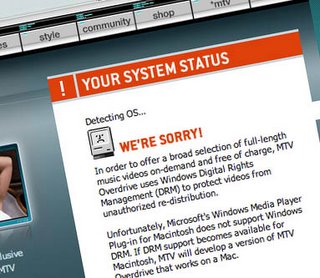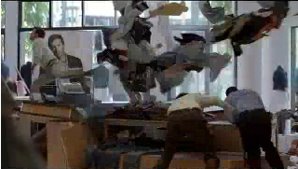Friday, December 09, 2005
Music Videos - the new frontier?!?
 The music video industry is in a downturn in 2005. The amount of major label videos being made is staying relatively level for the last few years. The "down" part comes from the budgets. They are way down.
The music video industry is in a downturn in 2005. The amount of major label videos being made is staying relatively level for the last few years. The "down" part comes from the budgets. They are way down.Lower budgets mean less ability for the directors to create their vision, or waste the record company's money on pointless effects and explosions - depending on how you see it. Lower budgets also mean less profits for music video production companies, producers, directors and the like. Many production companies have gone under - leaving a few at the top of the marketplace and dozens of mini-shops with just one or two directors that might make three videos in a "big" year.
For a while, there has been talk that the music video industry is going to die. I don't believe this to be true. Things are changing, but labels will always want to promote their artists and videos are here to stay.
There are suddenly many new places to watch videos and that has led some people to declare that videos are "back". Rolling Stone Magazine even wrote a piece on this:
For the first time since MTV went on the air in 1981, videos are no longer free promotional tools for CDs -- they're the product. Twenty days after iTunes made music videos and television shows available on October 12th, Apple had sold 1 million downloads (top sellers included the Black Eyed Peas' "My Humps" and Kanye West's "Gold Digger"). "[iTunes] is hopefully going to prove that there's such a demand for video that people will pay for it," says music video director, Dave Meyers.I'm not convinced that the industry is "back," at least not back to where it was in the late 1990s. Things never go back, they just change as they move forward. Kids watch videos on the internet and now are even paying iTunes or their cell phone provider to download them. How will that affect the budgets and numbers of videos made? Well, I'm not scheduling the parade just yet.
Labels may be able to sell a few thousand copies of a Hawthorne Heights clip over the internet and people will certainly try and watch them for free on places like Launch, AOL and MTV as much as they can. I don't believe that this is going to prompt a renaissance with labels pouring money into production. As previously discussed, individual videos are now spread out to so many outlets, they don't reach enough people to justify spending half a million dollars to produce. Music videos will definitely get made, but I believe they will start to look more like cool little home movie/art projects for bands/artists rather than the splashy visual extravanganzas of the glory days.

Universal started the trend of charging a fee for websites that let people watch videos and this is the first of many steps in the label's efforts to take back control of the marketing tool (videos) that they are paying to produce, and had been distributing for free. If labels make money off videos, will they pay director's residuals like TV and film people get? If labels make enough off a popular video, will that prompt them to make more videos, or spend more money on the clips on that artist's next single? My guess is that additional money the labels bring in will largely stay in record company pockets. That is what record labels are best at. Ask Chuck Berry or any of the old Motown artists.
Labels: music video
Thursday, December 08, 2005
Our first visit from the Mystery Artist
 The photo here will represent our Mystery Artist - but rest assured the person in this story was not Elvis. Today, MA is a male - but next time it could be a female or even a group. Like the Hero With a Thousand Faces, MA is everywhere.
The photo here will represent our Mystery Artist - but rest assured the person in this story was not Elvis. Today, MA is a male - but next time it could be a female or even a group. Like the Hero With a Thousand Faces, MA is everywhere.Back in the late 90s we were working on a concept for a video starring a big-time rapper who was also doing a lot of acting. This was one of the times where the artist had specific wants and the label said we were to help him conceptualize it however he wanted. Anyway, MA wanted the video to be about his journey home from LA to his native NYC to see his wife.
In and of itself this was not necessarily a bad idea,in my opinion, the song was relatively romantic so it seemed to fit. The deal was that MA wanted the journey to be about how he returned home with his car - a high-end Mercedes S600. Okay, you might be thinking, a cross country driving video, right?

No. MA wanted his precious car to be transported by every way other than driving. The video was supposed to star out with the Benzo in the back of a truck, which breaks down and then car ends up inside a freight train car and then is on a boat across the water into NYC where, then and only then, he drives it off the boat to go see his wife.
Okay, that seems a bit elaborate, but MA is paying after all. No one at the label wanted us to talk budgetary concerns with MA so as he would not be offended. We went ahead with this concept - writing the treatment and working out a budget with a multiple day shoot all across the country, renting an S600 and the details of shooting on a moving train, etc. The job has not been awarded yet, and no one has received any money, we are just working on this to see how much it would cost. But the whole time, no one can question the all-mighty MA about the possible expense of the idea so we keep going forward.
The label finally asks us to tell them (not MA) what the cost would be for this cross country jaunt and we come up with a budget over $1 million. The label understandably declines. They finally confront MA about this ridiculous idea and tell him it's not happening. At this moment MA reveals that he doesn't just want us to use any old rented S600 (renting picture cars is standard in videos) MA wants us to use his S600 - AND it is currently wrecked and the production needs to pay to have the pricey bodywork done before the shoot.
The label finally grasped how money-grubbing nuts MA was being and they suddenly stopped calling us. The job that had been a huge priority just up and disappeared. As far as I know, a video was never made for that song.
Labels: celebrity, music video, mystery artist
What's wrong with MTV?
 Have you watched MTV recently? Probably not, because the last time you did you probably did not see the music videos you were looking for but instead got episodes of "Drunken Teen Roommates Arguing" or "That One Rapper Putting Shit Into Junker Cars." Clearly MTV has decided that, despite receiving big-budget videos for free from the labels, their network will get better ratings (and better profits) from lifestyle programming.
Have you watched MTV recently? Probably not, because the last time you did you probably did not see the music videos you were looking for but instead got episodes of "Drunken Teen Roommates Arguing" or "That One Rapper Putting Shit Into Junker Cars." Clearly MTV has decided that, despite receiving big-budget videos for free from the labels, their network will get better ratings (and better profits) from lifestyle programming.Today, MTV has very few videos running during the day and evening. Other than TRL - their daily top ten show with a largely teeny-bopper audience - Mothership MTV airs almost no music videos. Strange, but true.

Viacom, who owns MTV, has many other channels for you to watch - MTV2, VH1, MTVJams and now they even bought BET. Plus there are non-Viacom channels like Fuse, GAC, CMT and many more. You can catch lots of videos on these other, non-mothership networks - and they are even tailored more to your specific taste (MTV Latino, anyone?). If you know which channel to turn to (and that is often a big if) it might actually be easier to find a video you like than it was in 1989. The internet has also become the place where many people turn to watch videos - guaranteeing the viewer that they will get exactly the video they want, when they want it - assuming their browser can play the video format. (more on the internet and video watching another day)
The reason MTV became the force it did in the industry was that it allowed labels to reach viewers across the entire United States through a single outlet. This was much better for the labels than radio, where the record companies had to convince (via payola, hookers and cocaine) that individual radio stations should play the song the label wanted them to play. Reaching radio station managers in Phoenix, Buffalo, Pittsburgh and Mobile was a lot of expense and effort, so the labels were overjoyed when MTV starrted to overtake radio as the place to get a new band seen and heard.
In 1995 if a label got their new artist onto MTV - they reached essentially every record buying teenager in America. Radio was often forced to follow MTV and play the songs that became hits through videos or risk alienating their audiences. Now, that the video market is divided up, the label has to work hard to get the video on a variety of networks (though Viacom is still a major player). Getting your hip-hop video on BET, may be good, but you are still only reaching a fraction of the audience that same video would have a decade ago.
This has led to the music video world being thrown into an uproar. Many production companies have gone under as budgets plummet and profit margins become razor thin. This is definitely a topic I will write about more, and you can trust that I will blame it all on MTV not playing music videos.

Labels: music video
Wednesday, December 07, 2005
How are music videos made? - part 1
When a record label wants to make a video for a particular artist, they reach out to directors that they think might be right for the project.
Music video directors are usually signed to a production company that helps out with organization, booking locations, hiring crew and paying for all that until the record label gets around to paying for their video. Production companies can be small with a single owner/operator director working out of his Los Feliz kitchen or a massive international operation with a huge stable of directors like HSI.
The directors also have a rep (short for “representative”) – who acts sort of like the agent for the director, soliciting work and all that. Sometimes the director’s reps are a part of the production company where the director is signed, other times the rep is a freelance person who could represent several directors at a variety of production companies. Many times the reps don’t wait for the label to reach out, but use their contacts in the industry to sniff out what projects might be coming up that they can get their directors to “write” on.
 If the label wants the director to write on a project (or when the rep convinces the label that their director is the perfect man for the job) the director gets a CD of the track, and a general idea of how much the label wants to spend on the project. The director may also get a copy of the lyrics and the input of the label, the artist, the manager – or whomever else is important enough to offer an opinion. The input can vary from "We want a party video with lots of color" to pages and pages of notes with the artist specifying which brand of designer clothes she is wearing as she delivers which lyric. The director then has a deadline, sometimes two weeks or maybe even two hours, from the label when they expect to hear the director’s pitch.
If the label wants the director to write on a project (or when the rep convinces the label that their director is the perfect man for the job) the director gets a CD of the track, and a general idea of how much the label wants to spend on the project. The director may also get a copy of the lyrics and the input of the label, the artist, the manager – or whomever else is important enough to offer an opinion. The input can vary from "We want a party video with lots of color" to pages and pages of notes with the artist specifying which brand of designer clothes she is wearing as she delivers which lyric. The director then has a deadline, sometimes two weeks or maybe even two hours, from the label when they expect to hear the director’s pitch.
This pitch is what the director “writes” – and could include a single paragraph or nine pages of single spaced text that looks like the psychotic writings of Spacey’s serial killer in Se7en. Directors also often include photos from magazines or movies that illustrate the look or style they are going for. This is the creative process and the idea can change many times before the record label ever sees it, and then change even more once they get involved. This can be a lot of work, especially sinmce the label pays the director nothing, if they don't hire him/her to direct the job. Directors and production companies eagerly jump through these hoops in the hopes of getting work (and the money they hope will eventually come), like an actress auditioning - but usually no casting couch.
The label comissioner (the record company person who organizes the process of director/label interaction) will look through the collection of concepts and pick out a few to pass up the ladder to the decision-making executives above him/her in the label hierarchy. Sometimes the manager of the artist or the artist themselves is involved – other times not. The label often has the director(s) they like for the job re-write portions of their respective concepts before coming to a final conclusion. The label signs a contract with the production company and production begins. Locations get scouted, DPs get hired and model/dancers get auditioned and so on.
This is a VERY simplified version of events and I will go into the (hopefully more interesting) specifics later – like the budgets, the artist demands, the bribery and the way billion dollar corporate conglomerates make crazy-ass million dollar decisions at the last possible minute.
Feel free to make comments with the link below.
Music video directors are usually signed to a production company that helps out with organization, booking locations, hiring crew and paying for all that until the record label gets around to paying for their video. Production companies can be small with a single owner/operator director working out of his Los Feliz kitchen or a massive international operation with a huge stable of directors like HSI.
The directors also have a rep (short for “representative”) – who acts sort of like the agent for the director, soliciting work and all that. Sometimes the director’s reps are a part of the production company where the director is signed, other times the rep is a freelance person who could represent several directors at a variety of production companies. Many times the reps don’t wait for the label to reach out, but use their contacts in the industry to sniff out what projects might be coming up that they can get their directors to “write” on.
 If the label wants the director to write on a project (or when the rep convinces the label that their director is the perfect man for the job) the director gets a CD of the track, and a general idea of how much the label wants to spend on the project. The director may also get a copy of the lyrics and the input of the label, the artist, the manager – or whomever else is important enough to offer an opinion. The input can vary from "We want a party video with lots of color" to pages and pages of notes with the artist specifying which brand of designer clothes she is wearing as she delivers which lyric. The director then has a deadline, sometimes two weeks or maybe even two hours, from the label when they expect to hear the director’s pitch.
If the label wants the director to write on a project (or when the rep convinces the label that their director is the perfect man for the job) the director gets a CD of the track, and a general idea of how much the label wants to spend on the project. The director may also get a copy of the lyrics and the input of the label, the artist, the manager – or whomever else is important enough to offer an opinion. The input can vary from "We want a party video with lots of color" to pages and pages of notes with the artist specifying which brand of designer clothes she is wearing as she delivers which lyric. The director then has a deadline, sometimes two weeks or maybe even two hours, from the label when they expect to hear the director’s pitch.This pitch is what the director “writes” – and could include a single paragraph or nine pages of single spaced text that looks like the psychotic writings of Spacey’s serial killer in Se7en. Directors also often include photos from magazines or movies that illustrate the look or style they are going for. This is the creative process and the idea can change many times before the record label ever sees it, and then change even more once they get involved. This can be a lot of work, especially sinmce the label pays the director nothing, if they don't hire him/her to direct the job. Directors and production companies eagerly jump through these hoops in the hopes of getting work (and the money they hope will eventually come), like an actress auditioning - but usually no casting couch.
The label comissioner (the record company person who organizes the process of director/label interaction) will look through the collection of concepts and pick out a few to pass up the ladder to the decision-making executives above him/her in the label hierarchy. Sometimes the manager of the artist or the artist themselves is involved – other times not. The label often has the director(s) they like for the job re-write portions of their respective concepts before coming to a final conclusion. The label signs a contract with the production company and production begins. Locations get scouted, DPs get hired and model/dancers get auditioned and so on.
This is a VERY simplified version of events and I will go into the (hopefully more interesting) specifics later – like the budgets, the artist demands, the bribery and the way billion dollar corporate conglomerates make crazy-ass million dollar decisions at the last possible minute.
Feel free to make comments with the link below.
Labels: music video
New Spike Jonze work
Spike is the man. He directed seminal clips like the Pharcyde one where they move in reverse, Beastie Boys 70s cop-show Sabotage (with a look that has now been copied to death) and the Fatboy Slim video with dancing Christopher Walken. I realize that I could create links to where you could find all those videos - but I'm not. If you don't remember what Sabotage looks like, you may be reading the wrong blog.
Anyway, Spike is now a huuge commercial director and he does very interesting work within a corporate framework. He did an IKEA spot a few years ago with a lamp on the sidewalk that was genius. He also did a new spot for the Gap showcasing how they are demolishing and redesigning all the Gap stores. I did pull up a link for this one - the long playing director's cut that will be much shorter (and probably less edgy) in a TV length :30. Enjoy, and dig the Grove locations with the old FAO Schwarz store.
The antville site has lots of intriguing clips and video links - mostly posetd by directors themselves. The stuff on antville is often low budget and super arty - definitely worth checking out. Maybe they have the IKEA commercial.

Anyway, Spike is now a huuge commercial director and he does very interesting work within a corporate framework. He did an IKEA spot a few years ago with a lamp on the sidewalk that was genius. He also did a new spot for the Gap showcasing how they are demolishing and redesigning all the Gap stores. I did pull up a link for this one - the long playing director's cut that will be much shorter (and probably less edgy) in a TV length :30. Enjoy, and dig the Grove locations with the old FAO Schwarz store.
The antville site has lots of intriguing clips and video links - mostly posetd by directors themselves. The stuff on antville is often low budget and super arty - definitely worth checking out. Maybe they have the IKEA commercial.

Labels: music video
Tuesday, December 06, 2005
NYTimes piece on the new Beck video - with ROBOTS!!

There is a cool new video for Beck and directed by Garth Jennings (Hitchhiker's Guide to the Galaxy) that stars some of those Sony robots. The robots move so smoothly they look like CG. It is interesting (at least to me) to see the Times write about videos.
Watch the video itself on the Beck site.
Read the NYTimes article.
Labels: music video
Music Videos, really?

I work in the music video industry. I am guessing that anyone reading this is simply really into music videos (or perhaps works inside the biz as well). Most people old enough to be out of high school do not spend much time watching videos, I am guessing you are not that kind of people.
I am not sure exactly what I am going to write about. The two heydays of video, the mid 80s and the late 90s, have passed and the industry is on to something else now. MTV barely plays videos at all, but there are more other outlets (from M2 to Fuse to Fuel) where videos are shown. Apple selling videos on iTunes is intriguing and that may lead us somewhere else all together. It will definitely be interesting.
Music videos are marketing. They are 4 minute commercials for bands and I love them. As the Lester Bangs character says in Almost Famous, "And then it just becomes an industry of... cool." That's what I do.
I want to write about the crazy, funny things that happen dealing with record labels, artists, directors and all the egos involved. The kind of work I do is not heavily involved with being on sets and hanging out with artists - so you won't hear juicy sex and drugs gossip from me. There are other places where you can read all about who does cocaine off of whose naughty bits.
Hopefully you will find it interesting.

Labels: music video
